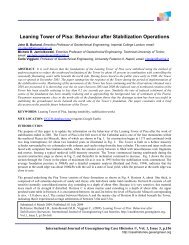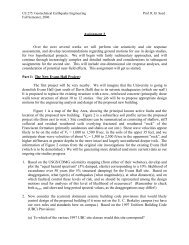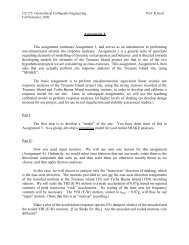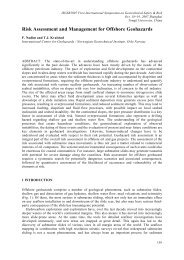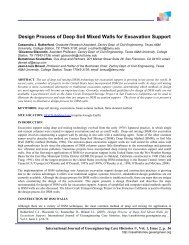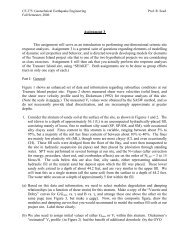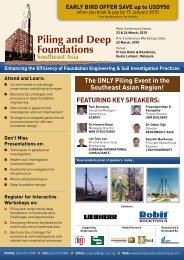Reliability Evaluation of Bored Piles with Multiple Defects - GEOSNet
Reliability Evaluation of Bored Piles with Multiple Defects - GEOSNet
Reliability Evaluation of Bored Piles with Multiple Defects - GEOSNet
Create successful ePaper yourself
Turn your PDF publications into a flip-book with our unique Google optimized e-Paper software.
<strong>with</strong> toe debris. However, the reliability <strong>of</strong> bored piles <strong>with</strong> multiple defects is not sufficiently<br />
investigated.<br />
The objective <strong>of</strong> this paper is to propose a methodology to quantitatively evaluate the reliability<br />
<strong>of</strong> pile foundations considering the possibility <strong>of</strong> multiple pile defects presence. For illustrative<br />
purposes, this paper will focus on voids and rebar corrosion. Discussions on other defects, such as<br />
cracks, soil inclusions, and toe debris are beyond the scope <strong>of</strong> the paper. The probability <strong>of</strong><br />
failure <strong>of</strong> the pile is formulated <strong>with</strong> a consideration <strong>of</strong> the possibility <strong>of</strong> multiple defects presence.<br />
A pile capacity reduction factor is presented to take into account the effect <strong>of</strong> pile defects on the<br />
pile capacity. Formulae for calculating the coefficient <strong>of</strong> variation <strong>of</strong> the pile capacity <strong>with</strong> defects<br />
are formulated. An example is presented to illustrate the proposed method.<br />
2 RELIABILITY OF PILES WITH MULTIPLE DEFECTS<br />
Consider the case <strong>of</strong> single bored piles <strong>with</strong> two types <strong>of</strong> defects, namely voids and rebar<br />
corrosion, along <strong>with</strong> other types <strong>of</strong> imperfections such as cracks, necking, and toe debris. The<br />
pile performance is still uncertain even when the pile is free from the considered two types <strong>of</strong><br />
defects due to the presence <strong>of</strong> other types <strong>of</strong> imperfections as well as many other sources <strong>of</strong><br />
uncertainty such as spatial variability <strong>of</strong> soils, various construction effects, and load effects. Since<br />
the effects <strong>of</strong> the defects could be correlated, the probability <strong>of</strong> failure <strong>of</strong> the pile due to the<br />
concurrent presence <strong>of</strong> those types <strong>of</strong> defects may not be the sum <strong>of</strong> the probability <strong>of</strong> failure due<br />
to individual types <strong>of</strong> defects. Based on the total probability theorem (e.g., Ang and Tang 2006),<br />
the probability <strong>of</strong> unsatisfactory performance <strong>of</strong> the pile <strong>with</strong> two types <strong>of</strong> defects, p f , can be<br />
calculated as follows:<br />
p = PF ( | E)(1 − p− p− p ) + PF ( | E) p+ PF ( | E) p+ PF ( | E ) p (1)<br />
f<br />
1 2 12 1 1 2 2 12 12<br />
where p 1 , p 2 and p 12 = occurrence probabilities <strong>of</strong> the first type <strong>of</strong> defect alone, the second type <strong>of</strong><br />
defect alone, and the concurrent occurrence <strong>of</strong> both types <strong>of</strong> defects, respectively; F = event <strong>of</strong> pile<br />
failure; E 1 , E 2 , E 12 and Ē = events <strong>of</strong> the first type <strong>of</strong> defect alone, the second type <strong>of</strong> defect alone, the<br />
concurrent presence <strong>of</strong> both types <strong>of</strong> defects, and the first or the second type <strong>of</strong> defect absence,<br />
respectively; P(F|Ē) and P(F|E i , i = 1, 2, 12) = conditional probabilities <strong>of</strong> unsatisfactory performance<br />
<strong>of</strong> the pile given the absence and presence <strong>of</strong> defects, respectively.<br />
The evaluation <strong>of</strong> conditional probabilities P(F|Ē) and P(F|E i , i = 1, 2, 12) can be formulated as<br />
follows. The probability <strong>of</strong> failure, p f , can be expressed in terms <strong>of</strong> β as follows:<br />
p = 1 −Φ (β)<br />
(2)<br />
f<br />
Where Φ = standard normal distribution function; β = reliability index. It can be seen that the<br />
probability <strong>of</strong> failure can be calculated based on the calculated β The reliability index <strong>of</strong> a pile<br />
can be calculated using the first-order reliability method. If both resistance and load effects are<br />
lognormal variates, then the reliability index for a linear performance function can be written as<br />
(Withiam et al. 2001)<br />
⎡ Q ⎤<br />
⎢<br />
λ FS( + 1)<br />
⎥ + +<br />
ln( ⎢<br />
)<br />
⎢<br />
⎢<br />
β =<br />
⎣<br />
D<br />
R<br />
2 2<br />
Q 1 COVQD<br />
COV<br />
L<br />
QL<br />
⎥<br />
2<br />
QD<br />
( λ )<br />
1<br />
R<br />
QD<br />
+ λ ⎥ + COV<br />
QL<br />
QL<br />
⎥⎦<br />
2 2 2<br />
ln((1 + COVR )(1 + COVQD + COVQL<br />
))<br />
(3)<br />
where FS = factor <strong>of</strong> safety in the traditional allowable stress design; λ R and COV R = bias factor<br />
and coefficient <strong>of</strong> variation (COV) <strong>of</strong> the pile capacity, respectively; Q D and Q L = nominal values<br />
<strong>of</strong> dead load and live load, respectively; λ QD and λ QL = bias factors for the dead load and live load,<br />
456



